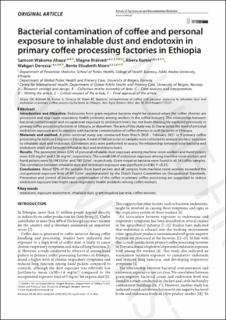| dc.contributor.author | Abaya, Samson Wakuma | |
| dc.contributor.author | Bråtveit, Magne | |
| dc.contributor.author | Kumie, Abera | |
| dc.contributor.author | Deressa, Wakgari | |
| dc.contributor.author | Moen, Bente Elisabeth | |
| dc.date.accessioned | 2024-01-19T09:14:35Z | |
| dc.date.available | 2024-01-19T09:14:35Z | |
| dc.date.created | 2023-11-09T11:44:01Z | |
| dc.date.issued | 2023 | |
| dc.identifier.issn | 1232-1966 | |
| dc.identifier.uri | https://hdl.handle.net/11250/3112717 | |
| dc.description.abstract | Introduction and objective:
Endotoxins from gram-negative bacteria might be released when the coffee cherries are processed and may cause respiratory health problems among workers in the coffee industry. The relationship between bacterial contamination and occupational exposure to endotoxin levels has not been thoroughly explored previously in primary coffee processing factories in Ethiopia, or elsewhere. The aim of this study was to characterize the level of personal endotoxin exposure and its relations with bacterial contamination of coffee cherries in such factories in Ethiopia.
Material and methods:
A cross-sectional study was conducted from March 2020 – February 2021 in 9 primary coffee processing factories in 3 regions in Ethiopia. A total of 180 personal air samples were collected to analyze workers’ exposure to inhalable dust and endotoxin. Correlation tests were performed to assess the relationship between total bacteria and endotoxin levels and between inhalable dust and endotoxin levels.
Results:
The geometric mean (GM) of personal inhalable dust exposure among machine room workers and hand pickers were 9.58 mg/m3 and 2.56 mg/m3, respectively. The overall GM of endotoxin exposure among machine room workers and hand pickers were 10,198 EU/m3 and 780 EU/m3, respectively. Gram-negative bacteria were found in all 54 coffee samples. The correlation between inhalable dust and endotoxin exposure was significant (r=0.80; P <0.01).
Conclusions:
About 92% of the samples from hand pickers and all samples from machine room workers exceeded the occupational exposure limit of 90 EU/m3 recommended by the Dutch Expert Committee on Occupational Standards. Prevention and control of bacterial contamination of the coffee in primary coffee processing are suggested to reduce endotoxin exposure that might cause respiratory health problems among coffee workers. | en_US |
| dc.language.iso | eng | en_US |
| dc.rights | Navngivelse-Ikkekommersiell 4.0 Internasjonal | * |
| dc.rights.uri | http://creativecommons.org/licenses/by-nc/4.0/deed.no | * |
| dc.title | Bacterial contamination of coffee and personal exposure to inhalable dust and endotoxin in primary coffee processing factories in Ethiopia | en_US |
| dc.type | Journal article | en_US |
| dc.type | Peer reviewed | en_US |
| dc.description.version | publishedVersion | en_US |
| cristin.ispublished | true | |
| cristin.fulltext | original | |
| cristin.qualitycode | 1 | |
| dc.identifier.doi | https://doi.org/10.26444/aaem/173222 | |
| dc.identifier.cristin | 2194480 | |
| dc.source.journal | AAEM: Annals of Agricultural and Environmental Medicine | en_US |
| dc.source.pagenumber | 611-616 | en_US |
| dc.identifier.citation | AAEM: Annals of Agricultural and Environmental Medicine. 2023, 30 (4), 611-616 | en_US |
| dc.source.volume | 30 | en_US |
| dc.source.issue | 4 | en_US |

